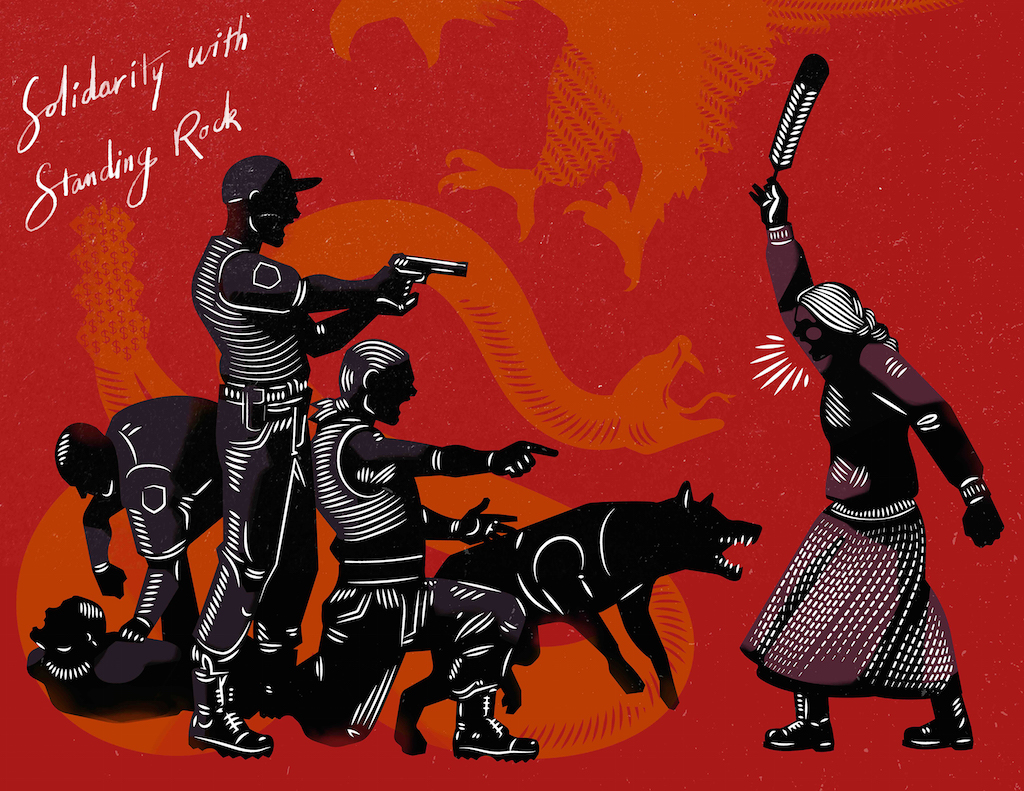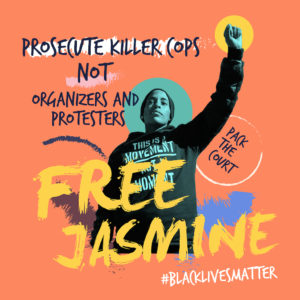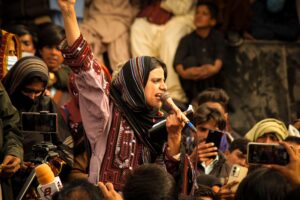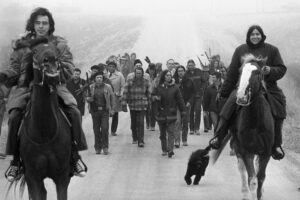Poster Power: The Dramatic Impact of Political Art
A new exhibition of political posters in Los Angeles puts a powerful spotlight on police abuses. From "In Solidarity With Standing Rock," a 2016 poster by Josh Yoder. (Center for the Study of Political Graphics)
From "In Solidarity With Standing Rock," a 2016 poster by Josh Yoder. (Center for the Study of Political Graphics)
 Photo Essay
The Power of Political Art
Photo Essay
The Power of Political Art
 Photo Essay
The Power of Political Art
Photo Essay
The Power of Political Art
In recent years, the shocking murders of unarmed African-Americans at the hands of police have horrified people throughout the nation and the world. The killings of Michael Brown in Ferguson, Mo., Eric Garner in New York City, Tamir Rice in Cleveland, Laquan McDonald in Chicago, Oscar Grant in Oakland, Calif., Walter Scott in North Charleston, S.C., and many others reveal the horrific pattern of police brutality and misconduct in the United States. The mysterious deaths of Freddie Gray in Baltimore after a rough ride in a police van and Sandra Bland’s so-called suicide in a Texas jailhouse only underscore the dangers that people of color have faced from police authorities for centuries.
Most of these atrocities are well known because of extensive media coverage. Still, the public should be reminded of the deeper historical roots of these tragic events in order to place them into a coherent yet disconcerting context. In that vein, two venerable Los Angeles public arts organizations have collaborated to present one of the most powerful and effective political art exhibitions in recent years. The Center for the Study of Political Graphics has organized an exhibit drawn from its massive collection of political posters, the most recent of 30 years of distinguished poster exhibitions on multiple themes.
See Truthdig’s photo essay depicting posters from the exhibition.
The show, which opened Dec. 16 and runs until March 2, is located at the Social and Public Art Resource Center (SPARC) in Venice, Calif. SPARC, too, has a distinguished history of exhibiting political art, often featuring works by outstanding artists from racial and ethnic minority communities that have long been ignored or underrepresented in mainstream cultural and artistic institutions. The present exhibition, “To Protect and Serve: Five Decades of Posters Protesting Police Violence,” is a stunning display of police misconduct over the past half century. The show’s 75 posters reveal a long and disgraceful history of police forces throughout the country targeting minority groups, the labor movement, the LBGTQ community, the homeless, the mentally ill, political dissidents and activists and others outside the bounds of conventional respectability and social conformity.
Funded primarily by the Mike Kelley Foundation for the Arts, the California Arts Council and the City of Los Angeles Department of Cultural Affairs, “To Protect and Serve” highlights graphics from the United States, Mexico, Chile and other countries. The exhibition’s categories add powerful thematic depth to public understanding of the serious problem of police abuse and misconduct: policing as political repression; racial and gender profiling; the school-to-prison pipeline; immigration raids; law enforcement and militarization; and organizing resistance.
Many of the posters address recent issues and events, including the grotesque police murders of unarmed African-Americans. Some of these vibrant and effective posters address the efforts of Black Lives Matter in raising national consciousness about black targets of American police; the continuing resistance to the Dakota Access pipeline of American Indians and their supporters at Standing Rock, N.D.; the notoriously racist and unconstitutional “stop and frisk” policy of the New York City Police Department; the U.S. Immigration and Customs Enforcement raids against undocumented women, men and children across the country; the Occupy movement protests throughout the U.S. and many other countries and police brutality against the demonstrators; the racial profiling in Arizona against Latina and Latinos under the notorious SB 1070 law, enforced by the odious former Sheriff Joe Arpaio; and the unspeakably horrible murders of hundreds of women in Juarez, Mexico.
While some of these struggles have abated (temporarily), others have continued. These contemporary posters remind viewers of the pressing problems in our pervasively flawed nation and world. They also serve to galvanize political opposition to some of the most glaring injustices of the early 21st century.
What makes this exhibition so remarkable, however, is its deep historical reach. The organizers have performed an invaluable public service by using poster art to show the long and dishonorable history of police brutality and official governmental repression that has spawned resistance among multiple segments of American society over the decades. Some of the graphics in this show are strikingly useful educational tools for teachers at many levels. The scheduling is particularly fortuitous in my own case: Beginning in January, I will be teaching an honors seminar on political art at UCLA, and I plan to arrange a class field trip to SPARC during the show’s run.
I will likely start my class presentation using one of the first posters displayed in the exhibition, titled “Caution!!” It is a reproduction of an 1851 abolitionist warning to black people about the 1850 Fugitive Slave Act, one of the most vicious pieces of legislation in the nation’s history. The poster specifically warned blacks about the severe dangers of the slave patrols, the first publicly funded police forces in America after the Revolution. The slave patrollers were often vicious in enforcing the act. Their brutality set a tone that has lasted to the present. Students—and everyone else—should be aware of these racist origins of modern policing. This poster contributes to that awareness.
Equally valuable is the 1979 poster by Carlos Cortez titled “Joe Hill.” Although I frequently discuss Joe Hill and his radical union, the Industrial Workers of the World (IWW), in several of my classes, the sad reality is that almost none of my students have ever heard of either the man or the union. A poet and songwriter as well as an effective organizer, Hill was executed in Utah in 1915 by firing squad after a highly questionable murder conviction. For the past century, he been a major symbol of labor martyrdom. The poster also encourages discussion about the IWW, itself a target of police attacks and brutality during the early 20th century, revealing the continuing record of police oppression against groups and individuals resisting the dominant powers of their times.
Even some of the mid-20th century’s most dramatic events have seemingly faded into obscurity. In May 1960 in San Francisco, the House Un-American Activities Committee held hearings to investigate alleged “Communist subversion.” Student protesters, many from the University of California at Berkeley, picketed and later entered the hearings and sang protest songs, disrupting this absurd remnant of the McCarthy era.
This graphic work reproduces the front page of the San Francisco Chronicle, with the headline “Battle of City Hall: 400 Cops Fight Student Crowd” topping a photograph of young protesters being dragged down the steps of City Hall. This work reveals a key historical source of the 1960s student movements at Berkeley, as well as the police brutality that would soon become a staple in student-based civil rights and anti-war protests throughout the decade.
During the protest movements of the 1960s and beyond, far too many people of color, some prominent and some not, were victims of severe and sometimes fatal police misconduct. Many of the individual posters in “To Protect and Serve” commemorate some of the human beings in that unfortunate category. Students should know all of these people and the circumstances surrounding their injuries or deaths.
Among others are posters about Fannie Lou Hamer (a civil rights leader beaten mercilessly in a Mississippi jail in 1963); Fred Hampton (a Black Panther Party leader murdered by Chicago police in 1969); Ruben Salazar (a Chicano reporter killed by a tear-gas projectile from the Los Angeles County Sheriff’s Department under mysterious circumstances in 1970); Dolores Huerta (a United Farm Workers leader brutally beaten by San Francisco police in 1988); and Rodney King (who was horrifically beaten by members of the Los Angeles Police Department in 1991). King’s beating precipitated the Los Angeles 1992 riots after the police officers were found not guilty by a jury with no African-American members.
The Rodney King graphic in this exhibition, created by Paul Conrad, is titled “One Picture Is Worth Zero.” Published in the Los Angeles Times the day after the four policemen who beat King were exonerated, Conrad’s graphic depicts a reconstructed image of the police striking King with their batons as he lay on the ground. Conrad’s point was that the white jurors blatantly disregarded the dramatic video of the beating that had gone viral almost immediately after the incident. Millions of people in the United States and throughout the world who saw the video properly concluded that King was the victim of outrageous police brutality.
Conrad was one of the most renowned political cartoonists of the late 20th century. This exhibition features other notable artists, including Art Hazelwood, Doug Minkler, Mark Vallen and Ramsess, all of whom have spent major parts of their creative careers combining outstanding visual form with trenchant social and political commentary. Students and other viewers can be encouraged to look at their other works and see the larger power of political art more fully.
This exhibition has extraordinary educational value. Education alone is valuable but insufficient; visual art has always served as one of the most powerful vehicles for inspiration and political action. As anti-slavery activist Frederick Douglass wrote, “Power concedes nothing without a demand. It never did and never will.” These posters cry out for a sustained collective activist response to police abuses. That is the deepest message of this exemplary poster exhibition.
see Truthdig’s accompanying photo essay with posters from the exhibit.
Your support matters…Independent journalism is under threat and overshadowed by heavily funded mainstream media.
You can help level the playing field. Become a member.
Your tax-deductible contribution keeps us digging beneath the headlines to give you thought-provoking, investigative reporting and analysis that unearths what's really happening- without compromise.
Give today to support our courageous, independent journalists.






You need to be a supporter to comment.
There are currently no responses to this article.
Be the first to respond.